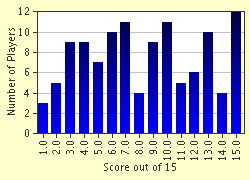Quiz Answer Key and Fun Facts
1. The French and Indian Wars were triggered when French and Algonquian Indians massacred the inhabitants of this city in 1690. Which?
2. The first phase of the French and Indian Wars lasted from 1690 until 1697. What is the name of the phase?
3. The second phase of the French and Indian Wars lasted from 1702 to 1713. What is the name of the second phase?
4. The third phase of the French and Indian Wars lasted from 1744 to 1748. What is the name of the third phase?
5. The fourth and final phase of the French and Indian Wars lasted from 1756-1763. What is the name of the fourth phase?
6. Name the person who built Fort Necessity.
7. Edward Braddock led an expedition to take over Fort Duquesne in 1755. He was very unsuccesful. The French and Indians massacured the expedition before it even got to Fort Duquesne. About half of the people in the expedition were killed. What is the nickname that he earned through his attitude?
8. When Fort Duquesne was finally taken over by the British, it was renamed what?
9. Fort Ticonderoga and Crown Point were located by two lakes. Name one of them.
10. The movie "Northwest Passage" (true story) is about Rogers' Rangers (a band of British-American people that utilize camouflage and sneak attack tactics who are named after their founder and leader: General Robert Rogers). Rogers' Rangers leave for an expedition from Crown Point to destroy a band of Abenaki Indians in 1759. In what settlement were the Abenaki Indians located?
11. The climax of the French and Indian Wars featured the French commander Louis Joseph de Montcalm versus General James Wolfe of the British at the Battle of Quebec. What is the name of the field that the battle took place?
12. After their triumph at Quebec, the British went on to take over this city. Which?
13. This treaty was signed in 1763 that officially ended the French and Indian Wars.
14. What land did the British *not* receive for winning the last of the French and Indian wars?
15. The British had huge debts because of the French and Indian Wars. In order to help get repay them, the British taxed many things in the American colonies, since they were the primary beneficiaries of the war. Which was *not* an item that was heavily taxed by the British?
Source: Author
greg84
This quiz was reviewed by FunTrivia editor
bloomsby before going online.
Any errors found in FunTrivia content are routinely corrected through our feedback system.

